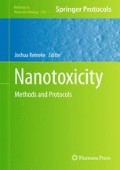Abstract
As nanotechnology rapidly emerges into a new industry—driven by its enormous potential to revolutionize electronics, materials, and medicine—exposure of living species to discharged nanoparticles has become inevitable. Despite the increased effort on elucidating the environmental impact of nanotechnology, literature on higher plants exposure to nanoparticles remains scarce and often contradictory. Here we present our biophysical methodologies for the study of carbon nanoparticle uptake by Allium cepa cells and rice plants. We address the three essential aspects for such studies: identification of carbon nanoparticles in the plant species, quantification of nanotransport and aggregation in the plant compartments, and evaluation of plant responses to nanoparticle exposure on the cellular and organism level. Considering the close connection between plant and mammalian species in ecological systems especially in the food chain, we draw a direct comparison on the uptake of carbon nanoparticles in plant and mammalian cells. In addition to the above studies, we present methods for assessing the effects of quantum dot adsorption on algal photosynthesis.
Access this chapter
Tax calculation will be finalised at checkout
Purchases are for personal use only
References
Oberdorster E (2004) Manufactured nanomaterials (fullerenes, C60) induce oxidative stress in the brain of juvenile large-mouth bass. Environ Health Perspect 112:1058–1062
Roberts AP, Mount AS, Seda B, Qiao R, Lin S, Ke PC, Rao AM, Klaine SJ (2007) In vivo biomodification of lipid-coated carbon nanotubes by Daphnia magna. Environ Sci Technol 41:3025–3029
Lu CM, Zhang CY, Wen JQ, Wu GR, Tao MX (2002) Research of the effect of nanometer materials on germination and growth enhancement of Glycine max and its mechanism. Soybean Sci 21:168–172
Zheng L, Hong F, Lu S, Liu C (2005) Effect of nano-TiO2 on strength of naturally aged seeds and growth of spinach. Biol Trace Elem Res 104:83–91
Govorov AO, Carmeli I (2007) Hybrid structures composed of photosynthetic system and metal nanoparticles: plasmon enhancement effect. Nano Lett 7:620–625
Khodakovskaya M, Dervishi E, Mahmood M, Xu Y, Li Z, Watanabe F, Biris AS (2009) Carbon nanotubes are able to penetrate plant seed coat and dramatically affect seed germination and plant growth. ACS Nano 3:3221–3227
Yang L, Watts D (2005) Particle surface characteristics may play an important role in phytotoxicity of alumina nanoparticles. Toxicol Lett 158:122–132
Lin D, Xing B (2007) Phytotoxicity of nanoparticles: inhibition of seed germination and root growth. Environ Pollut 150:243–250
Lin D, Xing B (2008) Root uptake and phytotoxicity of ZnO nanoparticles. Environ Sci Technol 42:5580–5585
Lin S, Reppert J, Hu Q, Hudson JS, Reid ML, Ratnikova T, Rao AM, Luo H, Ke PC (2009) Uptake, translocation and transmission of carbon nanomaterials in rice plants. Small 5:1128–1132
Chen R, Ratnikova TA, Stone MB, Lin S, Lard M, Huang G, Hudson JS, Ke PC (2010) Differential uptake of carbon nanoparticles by plant and mammalian cells. Small 6:612–617
Murashige T, Skoog F (1962) A revised medium for rapid growth and bioassays with tobacco tissue cultures. Physiol Plant 15:473–497
Hyung H, Fortner JD, Hughes JB, Kim JH (2007) Natural organic matter stabilizes carbon nanotubes in the aqueous phase. Environ Sci Technol 41:179–184
Eklund PC, Rao AM, Zhou P, Wang Y, Holden JM (1995) Photochemical transformation of C60 and C70 films. Thin Film Solids 257:185–203
Shang J, Ratnikova TA, Anttalainen S, Salonen E, Ke PC, Knap HT (2009) Experimental and simulation studies of real-time polymerase chain reaction in the presence of a fullerene derivative. Nanotechnology 20:415101
Kloepfer JA, Mielke RE, Nadeau JL (2005) Uptake of CdSe/ZnS quantum dots into bacteria via purine-dependent mechanisms. Appl Environ Microbiol 71:2548–2557
Weber WJ Jr (1985) Adsorption technology: a step-by-step approach to process evaluation and application. Dekker, New York
Ribeiro MHL, Lourenco PAS, Monteiro JP, Ferreira-Dias S (2001) Kinetics of selective adsorption of impurities from a crude vegetable oil in hexane to activated earths and carbons. Eur Food Res Technol 213:132–138
Sayes CM, Fortner JD, Guo W, Lyon D, Boyd AM, Ausman KD, Tao YJ, Sitharaman B, Wilson LJ, Hughes JB, West JL, Colvin V (2004) The differential cytotoxicity of water-soluble fullerenes. Nano Lett 4:1881–1887
Šamaj J, Baluska F, Voigt B, Schlicht M, Volkmann D, Menzel D (2004) Endocytosis, actin cytoskeleton, and signaling. Plant Physiol 135:1150–1161
Etxeberria E, Gonzalez P, Baroja-Fernandez E, Romeo JP (2006) Fluid phase endocytic uptake of artificial nano-spheres and fluorescent quantum dots by sycamore cultured cells: evidence for the distribution of solutes to different intracellular compartments. Plant Signal Behav 1:196–200
Acknowledgments
Ke acknowledges the support of NSF CAREER grant #CBET-0744040 and US EPA grant #R834092. Bhattacharya acknowledges a COMSET graduate fellowship. The authors thank Sijie Lin, Matthew Stone, JoAn Hudson, Junjun Shang, and Halina Knap for their valuable contributions cited in this presentation.
Author information
Authors and Affiliations
Corresponding author
Editor information
Editors and Affiliations
Rights and permissions
Copyright information
© 2012 Springer Science+Business Media, LLC
About this protocol
Cite this protocol
Ratnikova, T.A., Chen, R., Bhattacharya, P., Ke, P.C. (2012). Biophysical Methods for Assessing Plant Responses to Nanoparticle Exposure. In: Reineke, J. (eds) Nanotoxicity. Methods in Molecular Biology, vol 926. Humana Press, Totowa, NJ. https://doi.org/10.1007/978-1-62703-002-1_25
Download citation
DOI: https://doi.org/10.1007/978-1-62703-002-1_25
Published:
Publisher Name: Humana Press, Totowa, NJ
Print ISBN: 978-1-62703-001-4
Online ISBN: 978-1-62703-002-1
eBook Packages: Springer Protocols

